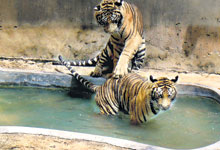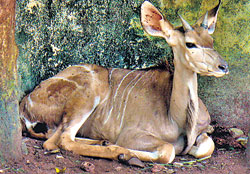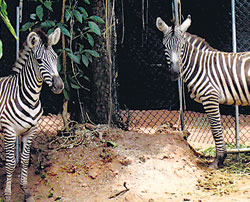Flight MH 189 from Kuala Lumpur emerged through the midnight skies and touched down at Katunayake on June 12. On board were some rather special passengers, tigers to be precise. Not of the human kind though - these were Royal Bengal Tigers.
One of the most powerful predators in the animal kingdom, the Royal Bengal Tiger can kill a man in a minute, but the three on board were safely confined in individual metal crates in the cargo section of the plane.
 |
| You scratch my back and I’ll scratch yours: The Royal Bengal Tigers enjoy a bath |
These tigers were part of the shipment from China’s Xiangjiang Safari Park to Sri Lanka.
There were more animals on the same plane from Xiangjiang Safari Park, a pair of zebras and a Greater Kudu –an antelope species. Both these herbivores are native to Africa, but had been bred successfully in Xiangjiang. Since they had too many, the Chinese zoo decided to enter into an exchange programme with Sri Lanka. In return, the Dehiwela zoo sent primates - two pairs of Endemic Toque Monkeys, two pairs of Purple-faced Leaf Monkeys, one pair of Silver Leaf Monkeys and a male chimpanzee who was born in the Dehiwela zoo.
The Xiangjiang Safari Park listed out the animals they were willing to provide and in return, local authorities sent a list of animals that the Dehiwela zoo could provide. After a round of negotiations, both parties were in agreement. Before selecting the available options the process involves careful assessment of suitability of conditions for the animals.
“The animal exchange programme with Xiangjiang focused on getting down new blood to stop inbreeding among tigers, zebras and Greater Kudu at the Dehiwela zoo,” said Deputy Director of the National Zoological Gardens Dammika Malsinghe, who spearheaded the animal exchange programme. The Dehiwela zoo had a pair of well-grown tigers, but their offspring were too weak and had not survived. Veterinary surgeons believe this was due to inbreeding among the same family. The new shipment included two female tigers and one male aged around one and a half years. Bringing down a male Greater Kudu was also to provide new blood to the existing Greater Kudu herd dominated by a single male. The Dehiwela zoo owns a pair of zebras, but they too haven’t bred so far.
It is indeed a busy period for the Dehiwela zoo. They are in the middle of another animal exchange and the latest shipment that arrived last Thursday included three pairs of Patagonian Cavy and a pair of Ring-tailed Coati from the Prague Zoo. The Ring-tailed Coati is native to South America and a relative of the raccoons. Patagonian Cavy - commonly known as Mara inhabit the larger Patagonian plains in South America. They can be quite social with humans, though in the wild they avoid humans. The zoo veterinarians have already separated a pair of fishing cats and a pair of giant squirrels now for more than four weeks to be exchanged and once the necessary medical formalities are complete, they will be ready to fly to the Prague Zoo.
 |
| Greater Kudu |
Zoo authorities work hard to bring in the new animals.
The pedigree of the animals needs to be properly maintained to facilitate a successful animal exchange programme. The Dehiwela zoo uses the global database International Species Information System (ISIS) to track data.
The animals in the zoo are given a special number and important information is stored in the system. The parents of the newborn are recorded, so their pedigree can be easily traced. Once in six months the updated information is sent to the central ISIS database, allowing any country to browse through the information. This process increases the zoo’s credibility and facilitates successful animal exchange programmes between zoos around the world.
The Dehiwela Zoo is also a member of the World Association of Zoos and Aquariums (WAZA), hence part of the international network.
Currently authorities are also negotiating with zoos in Singapore and Germany to get down a male giraffe and a sea lion.
All the newcomers can now be observed at the zoo. The new zebras were restless for a few days and initially kept in a small enclosure.
 |
| Still a bit restless: The zebras |
They were given a pen near the other zebras, but signs of aggression have forced the keepers to cover the surroundings at eye level to prevent mock attacks among them. However, keepers expect them to settle down soon.
The young Kudu spends most of its time under a shady tree in its pen. Initially it was kept alone and not given the company of a female Kudu.
The Ring-tailed Coati were also in a smaller confined area until they got used to their new home.
The Maras however are not shy at all and spend their day hopping around their enclosure.
The three young Bengal Tigers have already grabbed the visitors’ attention by their playful antics. The tigers like a cuddle and are already enjoying the company of their Lankan keepers.
So on your next visit to the zoo, don’t forget to greet the new arrivals. |



